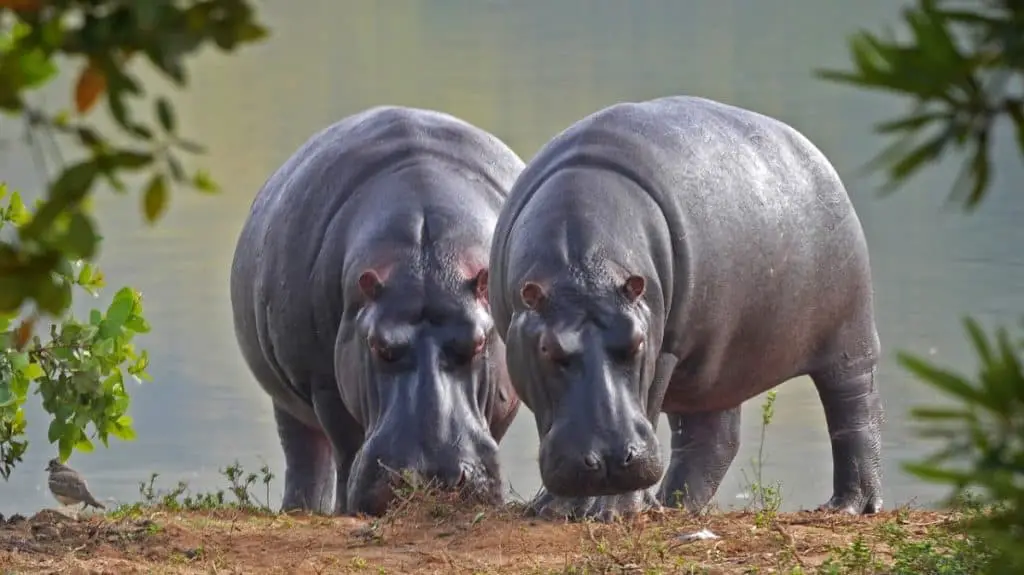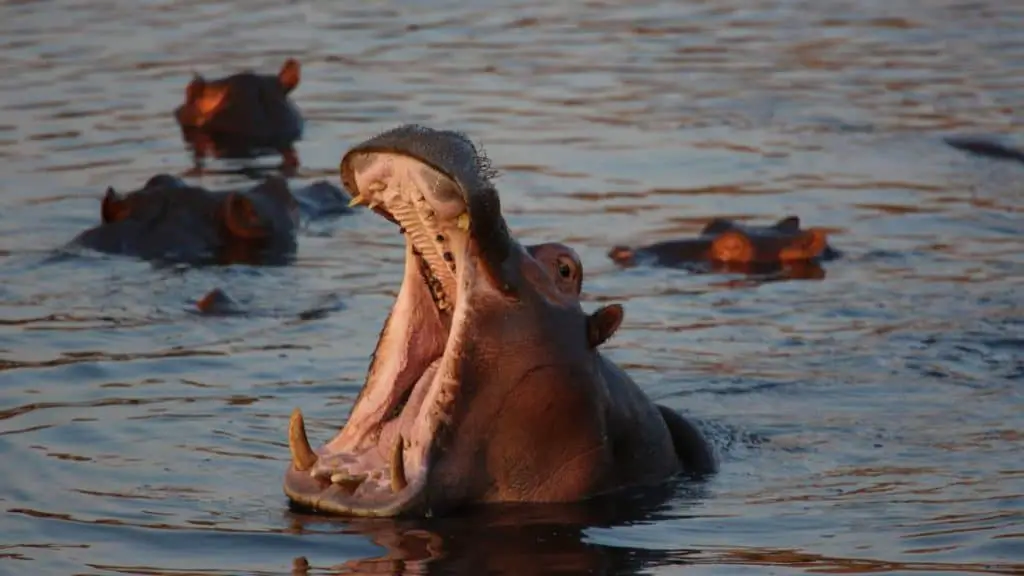The hippopotamus is the world’s third-largest land animal (after the elephant and rhinoceros). When I went to Africa recently, I couldn’t believe how big some of the hippos I saw were, so I spoke to some tour guides about why they grew so big.
There are two main reasons why hippos grow so large. The largest and most fierce male becomes the pack leader giving them access to breed. The hippo’s large size also helps when defending against predators. Larger animals are much harder to take down, even for pack hunters such as lions.
If you want to know more about why hippos grow so big, please read on.

What do hippos eat?
Hippos mainly eat during twilight and at night. They will stay in shallow water during the day to keep out of the hot African sun and then head to the grasslands to feast. Hippos will eat for about six hours and consume about 40 kilograms of food per day. Although this may sound like a lot, it is only about 1-2% of their body weight. In comparison, cattle can eat approximately 2-3% of their body weight.
Hippos will mainly feed on grasses that grow close to the water. These grassy areas are locally called ‘hippo lawns’ due to how neat and trimmed they are kept. During the night, a herd of hippos may move many kilometres as they look for food once the surrounding vegetation has been consumed.
The nighttime travel can take them to new rivers and lakes. In addition to grasses, hippos will feast on any fruit they find. Hippos do not need to eat as much as some other animals because of the relaxed lifestyle that helps them conserve energy.
If you want to know more about what hippos eat, I have written an article which you can find here
How much do hippos weigh?
Due to their immense size, wild hippos are extremely difficult to weigh, but using our knowledge of the animals is good enough to estimate. Male hippos grow for their entire life, so the older they are, the larger they become.
The largest hippo recorded weighed 4500kg, but males will generally average between 1500kg and 3200kg. Hippos stand at around 1.5m, and they are about 3.5m to 5m in length.
When they are first born, hippos are considered very large, with a baby hippo weighing 20kg to 45kg. The mother will give birth underwater, but they will nurse their young on land.
While hippos are big, the way they act can appear contradictory. Hippos are often temperamental and should be avoided at all costs.
Hippos are the most dangerous animals in Africa. Find out why in this article I wrote.
How hippos act in the wild
Hippos are often shown wallowing around in the mud and being peaceful animals. However, this is not always the case. Despite being large and ungainly, hippos are pretty fast, running up to 48 km/h, faster than humans. Because of their size, they can only run a short distance.
In Africa, hippos are considered one of the most dangerous animals to encounter, and they are responsible for about three thousand deaths per year. Maybe more surprising is that hippos are herbivores and will not kill animals or people for food, although they will eat carcasses, including other deceased hippos.
In the wild, hippos are well known for being incredibly aggressive and protective of their young. If you approach a young hippo, you are likely to be attacked by all the females in the group, not just the mother.
In addition to being aggressive, these big hippos will attack with little warning. Therefore, if you value your safety, you should give them a wide berth if you see them in the wild. While it may seem like you’re safe in a boat, a hippo can be surprisingly fast when moving through water. There are many reports of boats being overturned when they encroach on a hippo’s territory.
Hippos generally congregate together and are commonly seen in herds of up to 30 individuals. However, one guide told me that he had counted groups of over 200. No matter the size of a group of hippos occasionally referred to as a bloat, there is always one leader.
The leader of the group is known as the dominant bull. Other than the dominant bull, most of the other members will be female. Younger males are allowed in the herd, provided they do not attempt to mate with any females.
A young hippo attempting to mate under the watch of the dominant bull will be seen as a challenge, and the resulting fight may end in death for the young male. With time a young male will grow large, and he may challenge for the right to lead the herd. However, a dominant bull may chase them off before they become too large. This type of dominance and challenge is one of the main reasons hippos grow so big.
Unveiling the Marvels of Hippopotamus: Nature’s Mighty River Guardians

Fun facts about hippos
Hippos live in areas that have a lot of water. They are considered semi-aquatic, spending about 16 hours a day in the water. Mainly residing in water has a few interesting effects on them. Firstly, the water helps keep them cool in the warm African sun, maintaining their skin by keeping in moisture.
One of the most interesting facts about the hippo is that they cannot swim. While a hippo is considered semi-aquatic, they cannot swim and are not even buoyant, which means they cannot float. Instead, a hippo will sink to the bottom and they will walk along the bed. Hippos propel themselves forward using their legs, which is different from swimming.
A hippo can hold their breath for about five minutes, and when they need air, they’ll jump from the bottom of the water to the top and then sink back down.
Hippos used to be found from China to Africa, but today they are primarily found in the sub-Saharan region of Africa. Their population decrease is most likely because of the loss of habitat and hunting by people.
Many local people in Africa still eat hippo meat, but it is illegal to sell the meat in markets as the animals are protected. Hippo meat is said to be not that much different from lamb, but it tends to be a little gamey in flavour. However, there are plenty of other meats around, so please don’t be tempted to try.
As with elephants, hippo tusks are made from ivory. While it is much softer than elephant tusk and rhino horn, unfortunately, poachers target the hippo. Many protected regions aim to keep the population safe, but hippo numbers have decreased by 8-18% in the last ten years.
Today, there are approximately 138,000 wild hippos alive, listed as vulnerable. However, as there are many programs to help support these beautiful animals, they’ll hopefully be around for many more generations.
Hippos have extremely large teeth but do you know why? Find out here
